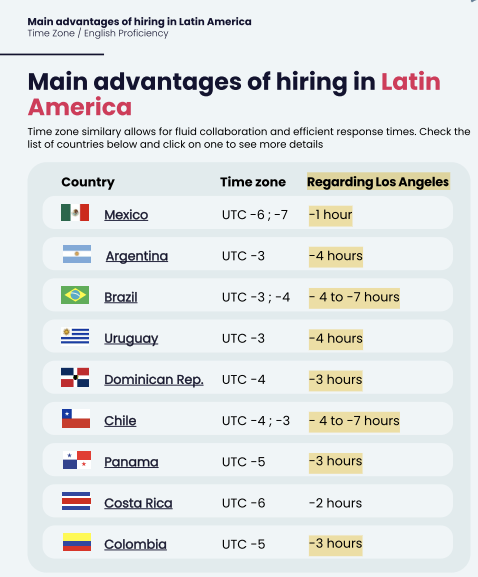Nearshore Software Development: A Closer Look
Introduction
In an era where digital transformation dictates market success, US businesses are continually seeking efficient, cost-effective, and innovative software development solutions. Enter the world of nearshore software development, a paradigm shift offering a plethora of advantages, particularly when looking towards Latin America. This blog post delves into why nearshore software development, especially in Mexico and other Latin American countries, is becoming a go-to strategy for US companies.

1. What is Nearshore Software Development?
Nearshore software development refers to outsourcing software development tasks to companies located in nearby countries, within similar time zones. This approach stands in contrast to offshoring, which often involves distant countries with significant time differences.
2. The Latin American Edge
Latin America, with countries like Mexico, Brasil, Argentina and Chile, are at the forefront, has emerged as a hub for nearshore software development. The region offers a pool of highly skilled developers, modern tech infrastructure, and an alignment in time zones that facilitates real-time collaboration.
3. Proximity and Cultural Affinity
One of the foremost benefits of nearshore software development is the alignment of time zones between the client and the service provider. Unlike offshoring, where companies might outsource their software development needs to distant countries with significant time differences, nearshoring involves working with teams in similar or adjacent time zones. This arrangement brings several key benefits:
Real-Time Communication: The similarity in working hours allows for real-time communication between teams. This immediacy is crucial in software development, where quick decision-making can significantly impact project timelines and outcomes.

Quicker Responses and Problem Solving: When teams work within the same or overlapping time zones, responses to queries or issues can be more prompt. This leads to faster problem resolution, keeping projects on track and reducing downtime.
More Effective Collaboration: Regular and timely interaction fosters a collaborative environment. Teams can work together seamlessly, conduct meetings without significant delays, and synchronize their workflows effectively.
We invite you to read these three detailed hiring guides in Latam
1. Hire Nearshore Developers in Latin America and South America- Part 1!
2. Hire Nearshore Developers - Part 2: Argentina, Chile, and Colombia!
3. Hire Nearshore Developers Uruguay, Dominican, Panama, and Costa Rica!
4. Cost-Effective Solutions
Hiring software developers in Latin America, can be more cost-effective than in the US, without compromising on quality. The economic benefits include lower hourly rates and reduced operational costs, making it an attractive option for startups and established businesses alike. When comparing software developer salaries between Latin America and North America, there are several factors to consider, including the average salaries in different Latin American countries, additional costs of hiring, and the economic benefits of hiring in these regions.

Average (USD$) Salaries in Latin America
- Brazil: The average yearly salary for a software developer in Brazil is approximately $47,823. Junior developers earn around $27,866, seniors around $75,800, and experts can reach up to $104,791
- Mexico: In Mexico, the average yearly salary for a software developer is around $36,324. Junior developers earn approximately $24,670, mid-level at $40,830, and senior developers $63,240, with experts earning up to $87,460
- Argentina: For Argentina, the average is about $29,556 per year. Junior developers earn around $21,676, mid-level $38,514, and senior developers $59,605, with experts earning up to $82,530
- Chile: The average salary in Chile is around $25,799 per year, with a typical full-time employee earning about 2,250,000 CLP/month (approximately $3500 USD/month)
Comparison with North American Salaries
- In the U.S., software developer salaries are considerably higher. For example, a senior developer in the U.S. can earn between $105,800 and $119,651 on average, depending on the region and company.
- The cost of living in major U.S. tech hubs like San Jose, San Francisco, and Seattle is significantly higher than the national average, which also influences the higher salaries in these areas.
Additional Considerations
- Operational Costs: When hiring from Latin America, operational costs like setup, communication tools, and potential time zone adjustments should be considered. However, these are often offset by the savings from competitive salaries in the region.
- Cultural and Geographical Proximity: Countries like Mexico offer advantages such as cultural affinity with the U.S., time zone compatibility, language proficiency, and geographical proximity, which can be beneficial for collaboration.
- Quality of Talent: Latin America is known for its growing tech industry, with countries like Mexico and Brazil having a rich culture of active developer communities and top-ranked educational institutions for technology.
|
Country/USD$ |
Junior Developer | Mid-Level Developer | Senior Developer | Expert Developer |
|---|---|---|---|---|
| Brazil | $27,866 | $51,833 | $75,800 | $104,791 |
| Mexico | $24,670 | $40,830 | $63,240 | $87,460 |
| Argentina | $21,676 | $38,514 | $59,605 | $82,530 |
Hiring software developers from Latin America can be more cost-effective for North American companies, offering competitive salaries without compromising on talent quality. The economic benefits include lower salaries compared to the U.S. and Canada, reduced operational costs, and the advantages of cultural and geographical proximity. However, it's important to consider the total cost of hiring, including additional operational expenses and the potential need for adjustments due to differences in time zones and work culture.
 Agile and Adaptable Nearshore Companies
Agile and Adaptable Nearshore Companies
-
Agility in Software Development: Nearshore companies in Latin America are known for their agility, a key component of modern software development methodologies like Agile and Scrum. This approach focuses on flexibility, iterative development, constant feedback, and the ability to adapt to changing requirements, which is crucial in today's dynamic tech environment.
-
Scalability: These companies can quickly scale their teams up or down based on project requirements. This scalability is particularly valuable for startups and established businesses that need to respond rapidly to market changes or project demands.
-
Adaptability: The ability to adapt to different working cultures and practices is another strength. Latin American professionals often share cultural and time zone similarities with North American companies, facilitating smoother collaboration and communication.
-
Technological Proficiency: Latin American developers are typically proficient in a range of modern technologies and are adept at adopting new tools and practices, ensuring they can contribute effectively to a wide range of projects.
-
Contract Flexibility: Nearshore companies often offer flexible contracting models. These can range from project-based contracts to long-term partnerships, providing clients with options that best suit their business needs and project scopes.
-
Cost-Effectiveness: While providing quality services, nearshore development in Latin America can be more cost-effective than hiring equivalent talent in North America, mainly due to lower labor costs in the region.
➡️➡️➡️You might also be interested in this link about nearshore experts.
The combination of a strong talent pool, agile methodologies, and adaptability makes Latin American nearshore software development an attractive option for companies looking to enhance their tech capabilities. These factors, coupled with cost-effectiveness and cultural proximity to North American markets, position Latin America as a key player in the global software development landscape.
Recent Posts
Conclusion
 Nearshore software development in Latin America, particularly in countries like Mexico, Argentina, Chile, Brasil, and so many more, offers an array of benefits for US businesses. From cultural and geographical proximity to cost advantages and a rich talent pool, it’s a strategy that aligns with the needs of a dynamic and ever-evolving tech landscape. As companies continue to seek innovative, agile, and cost-effective software development solutions, nearshore in Latin America!
Nearshore software development in Latin America, particularly in countries like Mexico, Argentina, Chile, Brasil, and so many more, offers an array of benefits for US businesses. From cultural and geographical proximity to cost advantages and a rich talent pool, it’s a strategy that aligns with the needs of a dynamic and ever-evolving tech landscape. As companies continue to seek innovative, agile, and cost-effective software development solutions, nearshore in Latin America!
Explore the Possibilities
Are you ready to explore the advantages of nearshore software development for your business? If you're considering hiring nearshore software development services, do it with specialists at ACL. We have over 200 clients who trust in nearshore software development daily. For more than 30 years, we have been providing these services, showcasing our experience and expertise in the field.

Our long-standing record in delivering high-quality software solutions and our deep understanding of the unique needs and challenges associated with nearshore projects makes us a reliable partner for your software development needs. Our team of skilled professionals is equipped to handle complex projects, ensuring that we deliver innovative, efficient, and cost-effective solutions. Choose ACL for a partnership that combines experience, trust, and cutting-edge technology in nearshore software development.







